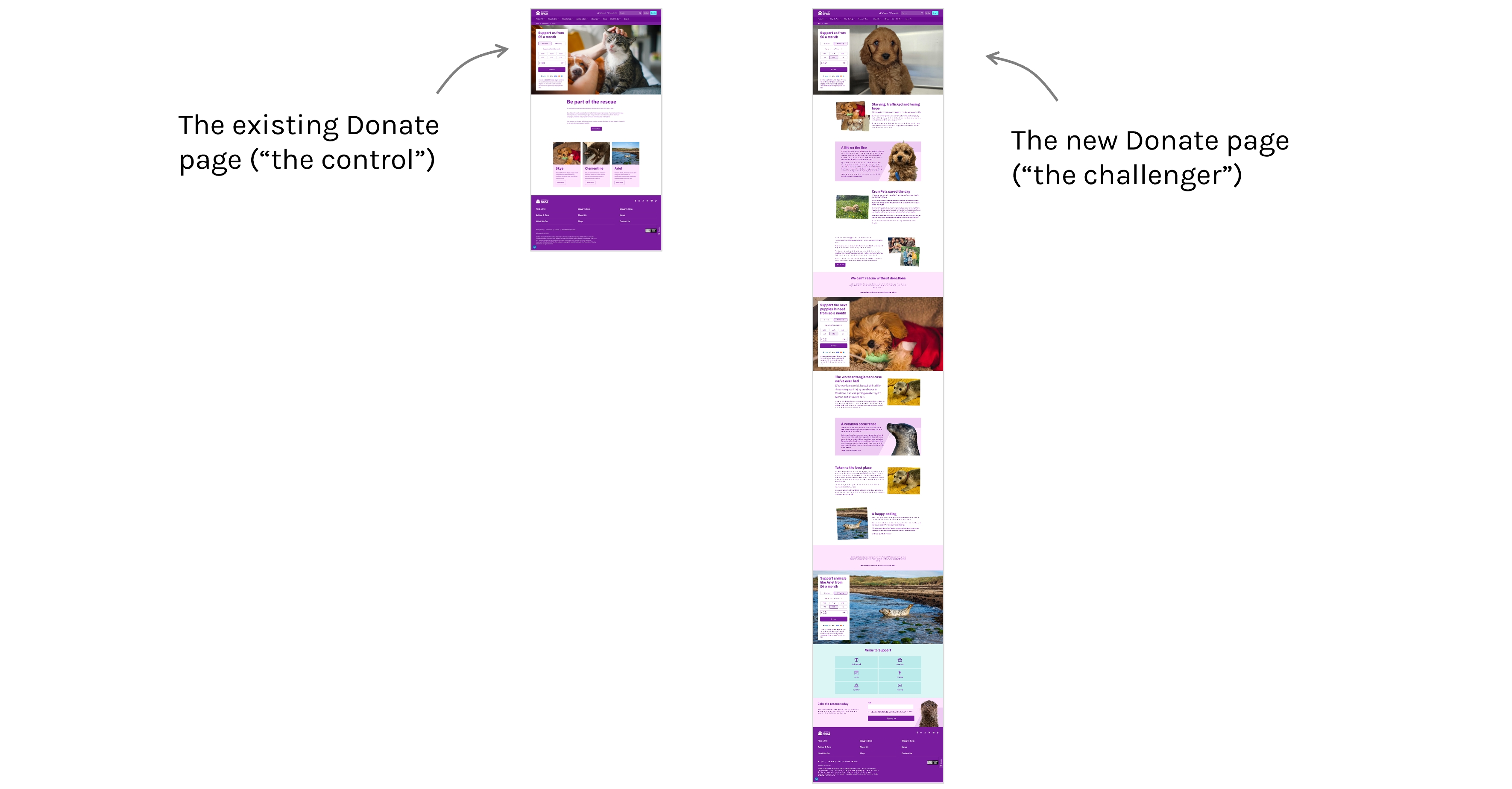How to increase recurring donations using empathy, memorability & defaults
Ian Duncan • 28th May 2025

Charity marketers know it’s the emotional stories that drive recurring donations.
And sadly, most charities have a wealth of emotional raw material available.
But how do you know if you’re making the most of it?
Against a backdrop of rising competition for monthly recurring donations and falling donation levels, that question is more important than ever.
To help you in your quest to up repeat support, we’ll cover:
- Two research-backed psychological principles that, taken together, help explain how and why emotional empathy influences recurring donation levels. Spoiler alert: if you want to increase recurring donations, you need to double down on empathy and memorability.
- A split test where putting these principles into action resulted in a 42% increase in recurring donations for a national animal charity.
Identify the victim
The first principle is the Identifiable Victim Effect.
It’s a quirk of human nature where the way information is framed can drastically affect our perception of it. One death can feel like a tragedy, while the deaths of one million can feel alien, abstract and unrelatable – and as a result somehow easier to ignore.
The simple act of naming the victim in your story makes them seem more real (even if they’re not).
The power of the Identifiable Victim Effect has been demonstrated scientifically under various conditions.
In one study, participants were shown an interview with a fictitious terminally ill child, Sheri, and asked to empathise with her. 75% of participants subsequently opted to move Sheri up the waiting list to receive end-of-life care, despite being told this would disadvantage other kids in need of care. The participants even admitted they were aware this was unfair. But their emotions overruled their moral principle of justice.
In a separate meta analytic review of the Identifiable Victim Effect, researchers noted that “in almost all cases, an individual life described in detail elicits more emotional reactions and aid than an equivalent life described as a statistic.”
They go on to say: “This effect holds even when the identification occurs via minimal or trivial information, such as age, name, or picture”.
The implications for charities are clear – tell the stories of named individuals, and beware the lure of statistics.
Stories are more memorable than stats
The second principle is Compassion Fade.
People’s beliefs are more durably impacted by stories than statistics. In other words, they remember the story for significantly longer than they remember the statistic, making their compassion more long-lasting.
In a set of controlled experiments researchers observed how “the average impact of statistics on beliefs fades by 73% over the course of a day, but the impact of a story fades by only 32%.”
This will come as no surprise to anyone familiar with the world of memory competition. Memory champions can pull off seemingly superhuman feats, like memorising pi to 70,000 decimal places, or memorising a shuffled deck of cards in 12.74 seconds.
They do this by mentally converting abstract, hard to remember things into images in their mind that act as a kind of mental storyboard. For example, they might use a memory system to convert a series of numbers into a vivid and bizarre visual. In fact, the more bizarre, colourful, or emotionally charged you make the image you want to remember, the more memorable it becomes. Bizarre, colourful, emotional. All ingredients for a memorable story.
The takeaway for charities: to maximise durability of compassion, firstly make sure you are telling a story, not just relating stats, and secondly, make sure the story is vivid and charged with emotion.
Ensure there’s enough narrative runway
Story length matters. The more of a story we hear (and the more emotionally resonant it is) the more opportunities we have to feel empathy for the main characters.
(As an aside, this is why TV series get higher average scores on IMDB than films. A 10-part TV series has 10 or so hours to build an emotional connection with their audience, versus maybe 2 hours for a film).
The ad testing company, System1, has repeatedly found that ads built around a single ‘Fluent Device’ (a recurring character or scenario) significantly outperform those without.
Based on their findings, emotional engagement hinges on giving viewers enough narrative ‘runway’ to connect with a single, coherent story, rather than bombarding them with a rapid montage of disconnected scenes.
For charities, this highlights the importance of giving each story the time required to build a connection with a potential donor. And it suggests wider opportunities for charities to create their real life equivalent of a TV series, for example by returning to a favourite character to detail the next chapter in their story, and strengthen the emotional connection felt towards them.
The power of defaults
Perhaps the most well known illustration of the power of defaults comes from the paper “Do Defaults Save Lives“, where the authors quantify this effect in the context of organ donation.
They showed that countries with presumed-consent systems — where you have to opt-out of donating your organs — can achieve donor rates approaching 99%.
By contrast, the organ donation rate is only around 15% in countries where opt-in is the default choice.
For charities looking to increase monthly recurring donations, this insight makes it clear that testing different default donation types and amounts is a no brainer.
Applying this to an actual online donation page
To show these principles in practice, we used a blend of these ideas to create a new version of the donate page on the Scottish SPCA website. Our primary goal was to increase recurring donations.

We had noticed that plenty of people viewed the donation page, but many did not go on to donate.
Our hypothesis was that some of those donors must be close to donating (they had just clicked a link labelled ‘donate’ after all). But clearly, they needed a stronger nudge to take the final step.
Putting the principles above into action:
- We focussed on individual named animals — Skye, a puppy rescued from the illegal puppy trade, and Ariel, a seal that survived a terrible injury caused by a fishing line.
- We gave our stories enough narrative runway to allow emotional engagement with the reader, increasing the word count more than 5 times, from around 175 words, to over 1000 words. (Side note: there was some pushback from the team about this move; the assumption was that more words would distract users from the donation action we wanted them to take. The test proved that assumption was wrong.)
- We made the story vivid and charged with emotion — we deliberately focussed on two emotionally charged rescue stories, each with a story arc going from hard-hitting rescue, to rehabilitation, to happy ending (a lovingly rehomed Skye the puppy and a healed, healthy Ariel the seal released back into the wild).
- We set the default donation type to monthly recurring and increased the default amounts.
We set up our A/B test so each page version would receive 50% of visitors to the Donate page.
The test reached 96% statistical significance, and our new challenger version of the donation page generated a 30% uplift in donation conversion rate versus the control variant.
The challenger page also took over 9.3% more in absolute total donation revenue, and crucially it generated over 42% more recurring donations versus the control.
Looking for ways to improve conversion rates for your organisation? Let’s talk.
Or for more examples of our work, check out our charity case studies.


